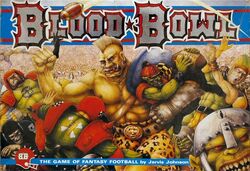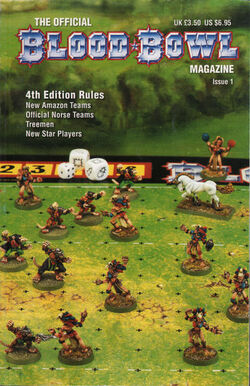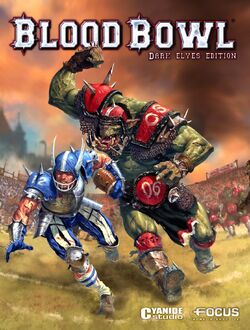
|
Wikipedia Import: Much of the content of this article was imported from Wikipedia, as a starting point for Blood Bowl Legendary Edition Wiki. This article will be re-written and reformatted in the near future. If this article is rewritten/reformatted, please remove this notice. |

Blood Bowl is an ultra violent team sport, based on the Warhammer Fantasy world. Build up your team with Orcs, Elves, Dwarfs and many other fantasy creatures before jumping into the bloodiest arenas! Blood Bowl was originally created by Jervis Johnson and Games Workshop in 1987. The board game, a parody of the Warhammer world and American Football, met with success in the 80s and the 90s. The world's largest Tabletop Wargames company continues to sell the game's miniatures today. Also, its creator never stopped improving and enriching Blood Bowl's game system and universe with several rule changes. Today, Blood Bowl remains very popular around the world thanks to a large community of players and numerous dedicated fansites. As for old Blood Bowl players, they have unforgettable memories of all the passionate games they used to play. Throughout the years, the original Blood Bowl game has earned a legendary status.
History[]
Background[]
The Blood Bowl universe has its own fictional background story which establishes the tone and spirit of the overall game. Additional background exists to describe the demeanor and character of the Blood Bowl players with frequent reference to rule breaking and excessive violence in a lighthearted manner. The over-the-top nature of the game is reflected through the game's mechanics, including the use of stylized secret weapons ranging from chainsaws to spiked steamrollers, the ability for large teammates to throw small teammates down field (even while they possess the ball), as well as in-game effects like fans throwing rocks and injuring players prior to kickoff.
Blood Bowl includes numerous tongue-in-cheek references to real life products and companies. The deity overseeing Blood Bowl is Nuffle (a pun on the pronunciation of NFL). The game spoofs at least four real-world trademarks, including McDonald's (McMurty's), Budweiser (Bloodweiser), Adidas (Orcidas), and Gatorade (Kroxorade). Many team names in the game's background are spoofs as well such as the Orcland Raiders (Oakland Raiders) and the Darkside Cowboys (Dallas Cowboys). Famous sporting personalities are parodied as well, with the most famous (and oldest) coach in Blood Bowl's background being Tomolandry the Undying (Tom Landry), and one of the most recently added stars being the Ogre thrower, Brick Far'th (Brett Favre).
With the advent of the 3rd edition, Blood Bowl moved closer to the traditional Warhammer Fantasy Battle world by changing the miniatures to look more similar to their Warhammer Fantasy Battle counterparts. Jervis Johnson, designer of the game, has admitted this was not the best direction for the game, and has since stated that the Blood Bowl world is similar to, but definitely not the same as, the Warhammer world. Recent changes to the rules reflect this, and newer miniatures for the game look more sporty in nature.
First Edition[]

Blood Bowl 1st Edition Box Set
Blood Bowl was initially released in 1986 by Games Workshop. This simple game utilised many of the elements of Game Workshop's existing tabletop games. A strategic yet tactical game, Blood Bowl parodied both the Warhammer Fantasy world and American Football. American Football had been quite popular on the United Kingdom's Channel 4 television station for a number of years and the GW staffers were obviously big fans themselves. The idea to take armoured fantasy figures and play out fantasy football was too tempting for the Games Workshop development team to pass up. The First Edition boxed set contained small cardboard pieces illustrated with the various players' likeness to represent the characters. Citadel Miniatures later released metal miniatures to represent the players. The playing field, or pitch, consisted of six interlocking carboard sections which had two opposing end zones and center, split into two halves, with each square marked by white lines.
In 1982, TSR published a game called Monsters of the Midway which was very similar in concept to Blood Bowl but significantly different in-game play. Discussions with Jervis Johnson at the Chaos Cup tournament in 2006 revealed that he had never seen Monsters of the Midway until after Blood Bowl was published and that the concept of a fantasy football board game was simply a concept whose time had come in the 1980s.
Second Edition[]

Blood Bowl 2nd Edition Box Set
Following the popularity of the First Edition, Games Workshop released the Second Edition of Blood Bowl in 1988. This iteration of Blood Bowl moved away from the battlefield mechanics of other Games Workshop systems and towards a more brutal sport-oriented play. The rules were totally revised with a complete reworking of the model profile being the most obvious. Gone was the complex profile of 1st Edition. The playing field now contained dug outs for each team to record the injuries to team members and to track their recovery. The rules were also simplified with a new Rulebook and a Playbook. During game play each team now took turns moving, blocking and advancing the football down the field. The box set also came with plastic miniatures to represent the players of each team.
Later, in 1990, Games Workshop released the "Blood Bowl: Companion" which brought the already popular game closer to the Third Edition. This guide introduced many of the features that would become central to the Third Edition, including re-rolls, fans, the weather and full campaign rules.
Third Edition[]

Blood Bowl Third Edition Box Set
Disappearing from shelves for awhile in the early 90's, the Third Edition of Blood Bowl was released in 1994. This newest iteration radically changed the game play from Second Edition. Gone was the complex and lengthy play, which was changed to a simpler, more dramatic edition of the game. These welcomed changes helped to increase the pace of the game, allowing a game to be played in the space of around two hours. The new box set also included a completely new range of 28mm miniatures which included new versions of both human and orc players in the box set. This new range of miniatures closely resembled their Warhammer Fantasy Battle counterparts. Mirroring the races of the Warhammer Fantasy armies, Blood Bowl continued to move closer to Warhammer Fantasy Battle. In 1995, Blood Bowl Third Edition won the Best Miniatures Rules for the 1994 Origins Award, an American award given for outstanding work in the game industry. The playing field of this edition consisted of a cardboard foldable playing board with squares marked by black crosses at the corner.
Fourth Edition[]

Blood Bowl Magazine Issue #1
In 2001, Jervis Johnson produced a new official Blood Bowl Fourth Edition rules and presented them in the Fanatic Game's Official Blood Bowl Magazine Issue #1, with follow-up rule presented in Issue #2. These new rules were a large departure from the previous Third Edition with numerous changes, some in which Johnson later admitted, "...some of the changes would have have benefited from rather more rigorous playtesting." The Fourth Edition rules, newly revised and corrected, were retitled 4th Edition Gold, and were placed on the Games Workshop website as a downloadable pdf file. Johnson announced that this newest iteration were now "experimental" and announced the creation of the Blood Bowl Rules Committee (BBRC), which consisted of Blood Bowl players and some Games Workshop staff, would gather annually to look at the rules and produce new rules changes and experimental rules for possible inclusion in future rules changes. Meeting in October each years, the BBRC released the first Living Rule Book (LRB1). The Living Rulebook, currently in its sixth edition, which is said by the BBRC to be the final version, is available for download online at various websites under the name "Blood Bowl Competition Rules Pack" or "CRP". Originally there were plans to release a printed version for Blood Bowl's 20th Anniversary, but this has since been cancelled. With the release of the CRP the BBRC was disbanded. All LRB updates include clarified or rewritten rules, coverage of previously unclear special cases, and game balance adjustments to skills, team lists, star players, cost and availability of star players and other special characters, ect.
Living Rulebook versions released by the BBRC include the following:

Blood Bowl Living Rulebook (4th Edition)
- LRB1 (2002) changes core rules about referees spotting fouls and use of wizards and league rules about player ageing (new) and the handicap system (overhauled from receiving extra Special Play cards to random choice on a table of favourable events).
- LRB2 (2003) contains small changes, with some focus on the rules for passing and intercepting the ball.
- LRB3 (2004) contains small changes.
- LRB4 (2005) rule changes enforce the minimum team size of 11 and make other minor improvements. Vampire and Ogre teams become official and the respective player skills are added. Handicaps are changed by removing half the possible random results because they had various issues.
- LRB5 (2006) changes cases of "turnover" (premature end of a player's turn), handling of stunned players and many parts of league rules: the sections about tournaments and playoffs is expanded, "spiralling expenses" are introduced as a way to handicap strong teams in the long term, post-game procedures are completely rewritten, random handicap rolls are replaced by "inducements" (the lower value team gets a budget to pay temporary players and other benefits), rules for post-game player improvements and results are modified, players can put team money in a "bank" (so that saved money doesn't count towards team value).
- In 2007 the BBRC approved Slann, Chaos Pact and Underworld teams, but they were not included in the subsequent official LRB/CRP releases for lack of official miniatures.
- LRB6 drafts, later re-edited as CRP (2009), contain small rule changes but significant changes to teams, star players and skills.
The majority of Blood Bowl is now played by the newest LRB6/CRP rules, often also allowing the 2007 teams; given the reliance on easy to change tables and lists and the tradition of playing leagues among friends or under the absolute authority of some organiser, customisation of allowed teams and star players and of prize and tournament structures, as well as adoption of some house rules, should be expected.
Copies of the Fourth Edition of the game, physically released in 2002, are almost identical to the third edition. All pieces remain the same; distinguishable elements include the 2002 copyright date and the editorial change from two rulebooks in third edition, both with play scenes on the cover ("Handbook" for core rules and "Death Zone" for background information and alternate or optional advanced rules), to the same material (updated to fourth edition rules) in a single "Handbook" (with the Blood Bowl trophy on blue background on the cover).

Death Zone Expansion 1st Edition

Blood Bowl Star Players 2nd Edition book
Expansions[]
Death Zone[]
Hot on the heals of Blood Bowl 1st Edition came the Death Zone expansion. This set contained a book of additional rules, team stats, new teams, improved Team Rosters and introduced a whole host of new races. This box set also included 178 additional carboard pieces representing the new teams. The new rules added to the game were: Interceptions; Stripping the Football; Jumping over Players and Pitch Invasions, as well as details for including Magic Spells in the game and full details for running campaigns.
With the success of Blood Bowl 3rd Edition, another "Death Zone" expansion was released. This set also contained a book which introduced new races such as Goblins, Chaos, the Undead, Half Elves, Halfling and Chaos Dwarf teams. Also included were 18 Star Player cards, 44 Dirty Trick cards, 45 Random Event cards and 27 Magic Item cards. Perhaps the most important new feature was a detailed template around which to base Bloodbowl Leagues. Players could gain new skills and abilities and the team would improve as the players become more experienced. Teams would have a Team Rating determined by how much they improve.
Star Players[]
The Star Players hardback book was released in 1989 by Games Workshop which introduced 48 Star Players into the game. A variety of new races were introduced to the game, including: Dwarfs, Elves, Dark Elves, Goblins, Undead, Skaven, Slann, Norse, Werewolves, Chaos Dwarfs and Chaos teams, along with rules for Halflings and the Snotlings.
Dungeonbowl[]

Elves & Dwarves - Dungeonbowl (2nd Edition)
Also introduced in 1989, was the Dungeonbowl expansion. Dungeonbowl, as its name suggests, is played in a dungeon and is a variant of the mighty popular Blood Bowl. Set in the Warhammer Fantasy world, the premise of the game is that wizards created Dungeonbowl to determine which Magic College was the most powerful. The game introduces some subtle modifications to the standard Blood Bowl rules. A match is still played between two teams, but each side is composed of three races. For example, the roster of a Rainbow Wizards team contains Elves, Halflings and Humans. The second difference is that the first team to score a touchdown wins the match. This task is made significantly more difficult by the fact that the ball is hidden in one of six treasure chests, five of which are booby-trapped with an explosive spell. Last, but by no means least, movement within the dungeon is both facilitated and complicated by teleporter pads. These allow players to magically zap from one position to another; a mishap, however, can lead to a player being zapped out of the match.

Kerrunch 2nd Edition Box Set
Kerrunch[]
With the success of the Blood Bowl franchise kicking into high gear, Games Workshop released a more light-hearted version of Blood Bowl known as Kerrunch in 1991. Developed by Andy Jones, this expansion was released along with other Games Workshop Games and was predominantly aimed at younger gamers (ages 8 and up) to help introduce them to the hobby. The rules were simplified from the original version of Blood Bowl Second Edition. The game included 24 plastic miniatures, and is considered a collector's item.
Gameplay[]
Blood Bowl is a two-player, turn-based board game that typically uses 28mm miniatures to represent a contest between two teams on a playing field. A board containing a grid overlay represents the field. Using dice, cards, and counters, the players attempt to score higher than each other by entering the opponent's end zone with a player who possesses the ball.
The term "Blood" in the title of Blood Bowl is represented by the violent actions available to players. Game play is based on a hybrid of American Football and Rugby. Players may attempt to injure or maim the opposition in order to make scoring easier by reducing the number of enemy players on the field.
The player races are drawn from the ranks of fantasy races and have characteristics that reflect the abilities of those races. Elves tend to be agile and good at scoring, while Dwarfs and Orcs are more suited to a grinding, physical style of play.
All teams offer a choice between player types with different statistics: related races (e.g. skeletons and zombies in undead teams, various lizardmen types), guests of allied races (e.g. trolls in orc and goblin teams), exotic or monstrous units (e.g. ghouls, wights and mummies in undead teams), and specialists of different roles (usually some combination of Blockers, Blitzers, Throwers, Catchers, Runners and Linemen). Teams can include any number of players of the most basic type (usually Linemen), while the stronger units are limited to 1, 2, 4 or 6 per team.
In league play, players gain additional skills and abilities based on their accumulation of experience points. Players face potential injury or even death on the field throughout their careers. Teams improve by the purchase of off-field staff such as cheerleaders, assistant coaches, and apothecaries. Disparity between team values is offset by the purchase of ad hoc star players or mercenaries, as well as bribes and additional temporary support staff, such as wizards or a halfling cook.
Video Games[]

Blood Bowl: Dark Elves Edition (PC Game)
Games Workshop first announced a series of video games based on their properties in 1990, to include a conversion of Blood Bowl by the UK company Tynesoft. However, Tynesoft went into bankruptcy before the game was released. Later, in 1995 Strategic Simulations, Inc. developed an MS-DOS version of Blood Bowl. Released by MicroLeague, this version of the game featured the base teams as well as many of the free agents.
In 2004, the French-based game company, Cyanide Studios developed a fantasy-based sports management game called Chaos League (and, later, a subsequent expansion Chaos League:Sudden Death). Released in Europe in 2004 and later in North America in March 2005, the game was a spin on American football, the violence of Medieval football with no rules and rugby-style of sports yet set in a fantasy world with teams comprised of various fantasy races. This game bore a heavy resemblance to Blood Bowl in its style and rules, even though it was a real-time game (rather than turn-based, like Blood Bowl). Games Workshop eventually sued Cyanide Studios over the similarities, but later announced that both companies had amicably settled for an undisclosed sum, and as part of the settlement, Cyanide Studios was granted a license to create computer games based on Blood Bowl. The settlement led directly to Cyanide's release of an official new version of the Blood Bowl game for Windows computers in June 2009 (with both "classic" turn-based mode and real-time mode).
In November 2007, various versions of the game were announced for the Nintendo DS, PlayStation Portable, and Xbox 360. In October 2010, Cyanide Studios released the Legendary Edition of Blood Bowl for the PC only, called Blood Bowl: Legendary Edition. This iteration of the game includes even more races, bringing the total races represented to 20. The Blood Bowl: Chaos Edition was later released in October 2012, adding a further three races, bringing the total to 23. Cyanide Studios has also released an adaptation of Dungeonbowl, by the same name, available for download on Steam.
Sources[]
- Blood Bowl: Competition Rules (2010)
- Blood Bowl: Competition Rules (2006)
- Blood Bowl: Living Rulebook 6 (4th Edition) (2010)
- Blood Bowl: Living Rulebook 5.1 (4th Edition) (2008)
- Blood Bowl: Living Rulebook 5 (4th Edition) (2006)
- Blood Bowl: Living Rulebook 4 (4th Edition) (2005)
- Blood Bowl: Living Rulebook 3 (4th Edition) (2004)
- Blood Bowl: Living Rulebook 2 (4th Edition), (2003)
- Blood Bowl: Living Rulebook (4th Edition), (2002)
- Blood Bowl (4th Edition) (2000)
- Blood Bowl (3rd Edition) (1994)
- Blood Bowl (2nd Edition) (1988)
- Blood Bowl (1st Edition) (1986)
- Blood Bowl: Companion (1990)
- Blood Bowl: Skaven Team (1st Edition) (1987)
- Blood Bowl: Star Players (1989)
- Blood Bowl: Elves, Dwarfs and Dungeonbowl (2nd Edition) (1989)
- Blood Bowl: Death Zone (3rd Edition) (1994)
- Blood Bowl: Death Zone (1st Edition) (1987)
- Kerrunch (1991)
- White Dwarf 86 (UK) Feb 1987, Pullout section which contained rules and a set of counters for Skaven teams
- Bowl Magazine Issue 1 (Oct 2000)
- The Citadel Journal 45, (2001)
- Blood Bowl (PC Game)
- Dungeonbowl (PC Game)
